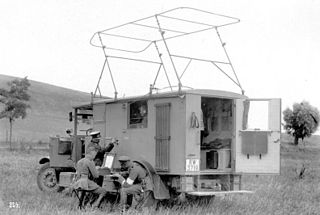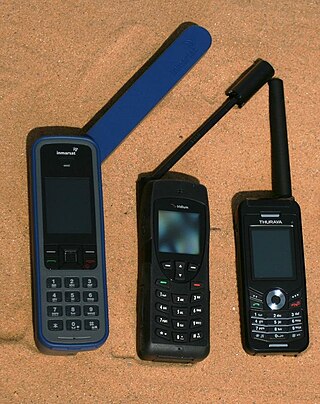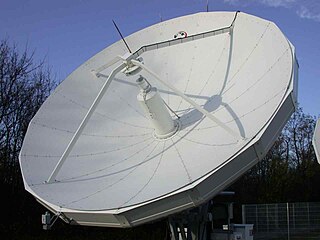
Land mobile station (or land mobile radio station) is a mobile radio station in the land mobile service that operates within a country or continent. [1]
Each station is classified by the service in which it operates permanently or temporarily.

Land mobile station (or land mobile radio station) is a mobile radio station in the land mobile service that operates within a country or continent. [1]
Each station is classified by the service in which it operates permanently or temporarily.

A coastradio station is an on-shore maritime radio station which monitor radio distress frequencies and relays ship-to-ship and ship-to-land communications.

As defined by FS-1037C and ITU Radio Regulations, radiodetermination is:
the determination of the position, velocity or other characteristics of an object, or the obtaining of information relating to these parameters, by means of the propagation properties of radio waves
Radiolocation, also known as radiolocating or radiopositioning, is the process of finding the location of something through the use of radio waves. It generally refers to passive uses, particularly radar—as well as detecting buried cables, water mains, and other public utilities. It is similar to radionavigation, but radiolocation usually refers to passively finding a distant object rather than actively one's own position. Both are types of radiodetermination. Radiolocation is also used in real-time locating systems (RTLS) for tracking valuable assets.

Land mobile service is – in line to ITU Radio Regulations – a mobile service between base stations and land mobile stations, or between land mobile stations.

Radio communication service or radiocommunication service is according to Article 1, No. 1.19 of the International Telecommunication Union's Radio Regulations, defined as "a service ... involving the transmission, emission and/or reception of radio waves for specific telecommunication purposes".
Mobile service is – in line to ITU Radio Regulations – a radiocommunication service between mobile and land stations, or between mobile stations (CV).

Mobile-satellite service is – according to Article 1.25 of the International Telecommunication Union's Radio Regulations – "A radiocommunication service

Land mobile-satellite service is – according to Article 1.27 of the International Telecommunication Union's (ITU) Radio Regulations (RR) – defined as «A mobile-satellite service in which mobile earth stations are located on land.»

Land station is – according to Article 1.69 of the International Telecommunication Union´s (ITU) ITU Radio Regulations (RR) – defined as "A radio station in the mobile service not intended to be used while in motion."

Mobile earth station is – according to Article 1.68 of the International Telecommunication Union's (ITU) ITU Radio Regulations (RR) – defined as "An earth station in the mobile-satellite service intended to be used while in motion or during halts at unspecified points."

A land earth station is – according to Article 1.70 of the International Telecommunication Union's (ITU) ITU Radio Regulations (RR) – defined as "An earth station in the fixed-satellite service or, in some cases, in the mobile-satellite service, located at a specified fixed point or within a specified area on land to provide a feeder link for the mobile-satellite service."

Aeronautical station is – according to Article 1.81 of the International Telecommunication Union's (ITU) ITU Radio Regulations (RR) – defined as "A land station in the aeronautical mobile service. In certain instances, an aeronautical station may be located, for example, on board ship or on a platform at sea."

An aircraft station is – according to Article 1.83 of the International Telecommunication Union's (ITU) ITU Radio Regulations (RR) – defined as "A mobile radio station in the aeronautical mobile service, other than survival craft station, located on board an aircraft".

Ship earth station is – according to Article 1.78 of the International Telecommunication Union's (ITU) ITU Radio Regulations (RR) – defined as "A mobile earth station in the maritime mobile-satellite service located on board ship."

Land mobile earth station is – according to Article 1.74 of the International Telecommunication Union's (ITU) ITU Radio Regulations (RR) – defined as "A mobile earth station in the land mobile-satellite service capable of surface movement within the geographical limits of a country or continent."

Coast earth station, also called the coast earth radio station is – according to article 1.76 of the International Telecommunication Union's (ITU) ITU Radio Regulations (RR) – defined as "An earth station in the fixed-satellite service or, in some cases, in the maritime mobile-satellite service, located at a specified fixed point on land to provide a feeder link for the maritime mobile-satellite service." Each radio station shall be classified by the service in which it operates permanently or temporarily.

Base earth station is – according to article 1.72 of the International Telecommunication Union's (ITU) ITU Radio Regulations (RR) – defined as "An earth station in the fixed-satellite service or, in some cases, in the land mobile-satellite service, located at a specified fixed point or within a specified area on land to provide a feeder link for the land mobile-satellite service."

Aeronautical earth station is – according to Article 1.82 of the International Telecommunication Union's (ITU) ITU Radio Regulations (RR) – defined as "An earth station in the fixed-satellite service, or, in some cases, in the aeronautical mobile-satellite service, located at a specified fixed point on land to provide a feeder link for the aeronautical mobile-satellite service."
Ship's emergency transmitter is – according to article 1.99 of the International Telecommunication Union's (ITU) ITU Radio Regulations (RR) – defined as «A ship's transmitter to be used exclusively on a distress frequency for distress, urgency or safety purposes.»

Aircraft earth station is – according to Article 1.84 of the International Telecommunication Union's (ITU) ITU Radio Regulations (RR) – defined as "A mobile earth station in the aeronautical mobile-satellite service located on board an aircraft."